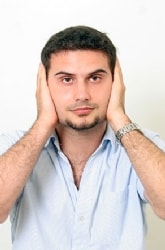
By Dr. Debra Griffin
We begin hearing in the womb, and the auditory processing part of the brain is the last sense to stop working when we are dying. While this may be a tough way to begin a conversation with you, I hope stating these facts works as a kind of wake up call. Since God designed us this way, the hearing sense must be vital to our being.
How does normal hearing work? Sound waves enter the ear canal and make the eardrum vibrate. The vibrations affect three other bones in the ear, which then “knock” on the cochlea, making the cochlea’s fluid move. The fluid movement stimulates the hearing nerve, which carries signals to the brain.
You might be thinking that this process seems like it would take a long time, but these types of signals happen almost instantaneously 24 hours a day, seven days a week. Yes, even when we are sleeping. When you are sleeping and the phone rings, the lower processing part of our brain that receives the signals from the hearing nerve sends its own signal to wake us up. We wake up and recognize that the phone is ringing.
Because hearing is vital to our being, it is important to protect the sense and to reverse any reduction that may have occurred, if possible.
10 surprising causes of hearing loss:
3 obvious causes of hearing loss:
There are three general types of hearing loss. Before we jump into them, let me make a very important point. It is crucial to be evaluated by a professional that will focus on the diagnosis of hearing loss. No recommendation for hearing aids or any other treatment solution should be discussed prior to this diagnostic evaluation. Often, the assumption is made by both the struggling individual and their family and friends that hearing aids are immediately the solution when that might not be true.
Sensorineural hearing loss is the most common type of hearing loss. This loss is due to damage to the inner ear, usually the hair cells within the cochlea. This can be caused by any number of the 13 listed above, but especially by noise exposure, aging, and hereditary factors.
Conductive hearing loss is a loss due to middle ear fluid, a buildup of ear wax, or physical trauma to the middle ear.
Mixed hearing loss is a combination of conductive and sensorineural. A condition known as otosclerosis is the most common mixed loss — a calcification of the smallest bone in the middle ear, disrupting all three middle ear bones and calcifying the cochlea in the inner ear.
As you can see, there are many different reasons we experience hearing loss. I hope this information hasn’t depressed you. Before a doctor can help, we must diagnose the problem and discover the cause(s). That is why it is so crucial to be evaluated by a qualified professional. Only then can you be sure that the best solution has been prescribed.
This is the first article in a three-part series on hearing loss. Click here to read the second article.
About the author: Dr. Debra Griffin was born and raised in Lake City, Florida. She received her bachelor’s and master’s degrees at Florida State University and her doctorate at the University of Florida. She began her career at Shands Hospital in Gainesville, then moved to Jacksonville (both in Florida), where she worked with an ENT practice. She later managed the first Walmart hearing center in Jacksonville, which led to her opportunity to pursue private practice. In June of 1998, Dr. Griffin returned to her roots in Lake City and founded Hearing Solutions, Inc. Dr. Griffin also has an office in Live Oak, Florida, and sees patients at Copeland Medical Center in Dowling Park every Tuesday.